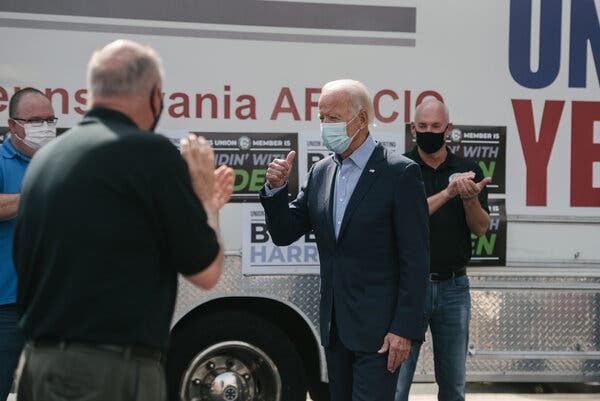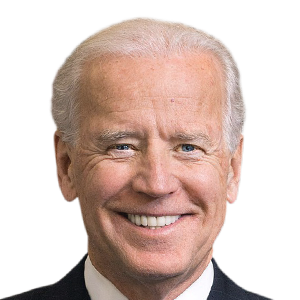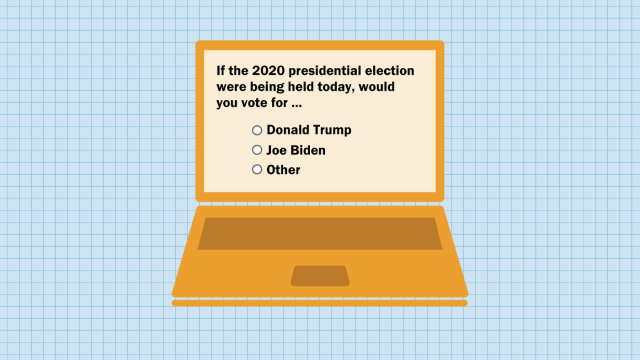Advertisement
President Trump had counted on his court nomination over the weekend to shift the election dynamic away from his handling of the coronavirus pandemic. But it has not reset the race in the key battleground state.

President Trump’s aggressive drive to add a conservative justice to the Supreme Court before Election Day has not helped him in Pennsylvania, a state crucial to his re-election, where more voters prefer Joseph R. Biden Jr. to fill the vacant seat, according to a poll by New York Times and Siena College released on Monday.
Mr. Biden led Mr. Trump, 49 percent to 40 percent, among likely Pennsylvania voters in the poll, which was conducted Friday through Sunday. On Saturday, Mr. Trump nominated Judge Amy Coney Barrett for the court seat and immediately flew to Pennsylvania to whip up support that night, speaking before a giant screen with the words “FILL THAT SEAT!”
But that prospect — which the Trump campaign is counting on to shift the election dynamic away from the president’s handling of the coronavirus pandemic — has not reset the race there. On the contrary, 51 percent of voters in the passionately divided battleground state said they trusted Mr. Biden more to pick the next justice, whereas 44 percent said that about Mr. Trump.
“I think the citizens of the United States should be picking out who will be the judge, but I would trust Joe Biden,” said Margarita Motta, 56, of Reading, Pa. “I will be voting for him.’’
Mr. Biden has not trailed in a public poll of Pennsylvania since June. But his lead narrowed over the summer as the state trended back toward tossup status, evoking memories of Mr. Trump’s slim victory there in 2016. The president has virtually no path to a second term without Pennsylvania’s 20 electoral votes. Mr. Biden could afford to lose the state, but only if he runs the table in other northern battlegrounds that Democrats narrowly lost in 2016 and picks up Arizona.
New York Times/Siena College poll of likely voters in Pennsylvania
Based on a New York Times/Siena College poll of 711 likely voters from Sept. 25-27, 2020.
The new poll, of 711 likely voters with a margin of sampling error of 4.3 percentage points, shows Mr. Biden nearly repeating his 10-point lead in a Times/Siena survey of Pennsylvania in June.
In moving rapidly to fill the seat held by Justice Ruth Bader Ginsburg until her death 11 days ago — a sudden turn of events that both campaigns see energizing their respective voters — Mr. Trump is pursuing a 6-3 conservative court majority that could potentially strike down abortion rights and the Affordable Care Act. But the move enraged Democrats over the Republican double standard after party leaders blocked a 2016 court nominee by President Barack Obama.
Alan Lee, 66, a retired pastor who counsels homeless men in Philadelphia, said he has “historically been pro-life” and voted Republican, but he now favors Mr. Biden because the president, he said, is a “demagogue” and Republican leaders have abandoned their principles.
“You’d think I’d be glad to hear that he nominated a judge who is pro-life,” Mr. Lee said. “But I think what we need more than anything else is someone who is broadly pro-life, not just worried about the unborn, but about the living.”
The failure of the Supreme Court opening to expand Mr. Trump’s support beyond his fervent base — personified by the red-hatted crowds who pack his airport hangar rallies, as they did outside Harrisburg, Pa., on Saturday night — is a klaxon alert for his campaign.
Among Pennsylvania voters who are not registered with either major party, Mr. Biden held a commanding lead, 48 percent to 27 percent, suggesting Mr. Trump is not growing his potential electorate.
Another warning sign for the president: Nearly half of all voters, 47 percent, “strongly disapprove” of how he handles his job as president, evidence of entrenched opposition with five weeks until Election Day and voting already underway in Pennsylvania. A smaller share, 32 percent, strongly disapproved of Mr. Biden.
The Biden lead, as in other battlegrounds, was driven by a yawning gender gap with women voters, as well as a narrower deficit with men compared to the 2016 election between Mr. Trump and Hillary Clinton. Women in the survey preferred the former vice president by 26 percentage points. Men sided with Mr. Trump by a narrower eight-point gap.
Both measures were an improvement for the Democratic nominee over 2016, when Mr. Trump eked out a 44,000-vote win in Pennsylvania, less than one percentage point, by carrying men by 17 points and only losing women by 13 points, according to exit polls.
Because Mr. Trump has lost favor among Pennsylvania’s suburban voters, who have ousted a series of Republican incumbents since 2016 in a rolling series of warnings for the White House, the president must compensate by raising support in rural counties, especially with white voters without four-year college degrees.
But among both subgroups, Mr. Trump lagged his 2016 benchmarks. He led with white voters without four-year degrees by 14 points; in 2016, he won these voters by 32 points, according to exit polls. Among rural voters, he held a 26-point lead; four years ago he won rural Pennsylvania voters by 37 points.
The first presidential debate on Tuesday night gives Mr. Trump an opportunity to shake up the race, and the poll suggested some Biden supporters are in a defensive crouch. Voters were closely divided on whom they expected to win the debate: 39 percent named Mr. Biden and 41 percent said Mr. Trump. Nearly three out of four voters who identified as Democrats expected a Biden win, with 9 percent expecting Mr. Trump to prevail and 17 percent unsure. Voters who identify as Republicans are slightly more confident that Mr. Trump will win.
“I’m nervous that Biden will fumble words or not be clear and get attacked, because Trump is a bully and Biden is not,” said Maryann Lemerise, 55, a Philadelphian who has rearranged her work schedule to make phone calls for Mr. Biden.
Laura Gallagher, 59, a pharmacy worker in the Lehigh Valley who is a strong Trump supporter, is looking forward to the debate. “I think it’s going to be a joke,” she said, “because I don’t think the Democratic candidate is going to be able to do it. I don’t think he has it in him.”
A third voter, Michael Sullivan, 54, who cast a ballot for the Green Party in 2016, is undecided and is looking to the debate to settle his choice. He said he would decide based on how the candidates handle themselves.
Mr. Biden is “like your grandfather, that you’re worried he’ll hurt himself if you don’t take his license away,” he said. He wants to hear Mr. Trump respond to questions with a “valid answer, not a deflection,” adding, “Then I might think of voting for him.”

With a deluge of mail ballots expected in the general election — the first time all Pennsylvania voters have that option — the poll found that nearly one in three planned to vote by mail.
But with Mr. Trump repeatedly denouncing mail ballots as ripe for fraud, despite a lack of evidence, there were sharp partisan differences on voting methods. Among voters who have requested an absentee ballot, 75 percent prefer Mr. Biden and 18 percent back Mr. Trump. Among voters who have not requested an absentee ballot, Mr. Trump is favored 48 percent to 40 percent.
“I do have concerns about integrity with too many mail-in votes,” said William Slye, a Trump supporter in Reading, Pa. When ballots are cast in person, “it’s difficult for people to fake it,” he said, although there is no evidence that the broad use of mail voting has led to fraud sufficient to swing a statewide election.
The huge partisan gap in voting methods, with Democratic voters expected to cast mail ballots in larger numbers, may lead to lopsided and shifting results on Election Night that could continue for several days as mail ballots are tallied. Pennsylvania remains one of a few swing states that does not allow officials to begin opening and processing mail ballots before Election Day.
Here are the crosstabs for the poll.





